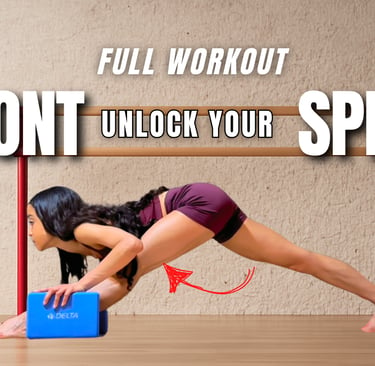Closed vs. Open Splits: Key Differences and Why They Matter for Flexibility Training
Descrição do pDiscover the difference between closed (square) and open (turned-out) splits. Learn which split suits your goals—ballet, yoga, or gymnastics—and how each impacts your flexibility and technique.ost.


In the world of flexibility training, understanding the nuances between different split techniques is crucial for achieving optimal performance and preventing injuries. Two primary variations are the Closed (Square) Split and the Open (Turned-Out) Split. Each serves distinct purposes and is favored in different disciplines such as ballet, gymnastics, and yoga.
Understanding the Closed (Square) Split
The Closed Split, often referred to as the Square Split, is characterized by hips that are aligned and facing forward. This alignment ensures that both hip bones (anterior superior iliac spines) are squared to the front, promoting symmetry and balance.
Key Features:
Hip Alignment: Hips are squared, with both hip bones facing forward.
Front Leg: Externally rotated, resembling a passé position.
Back Leg: Internally rotated, with the knee and top of the foot facing the floor.
Torso: Remains upright and aligned without rotation.
Benefits:
Symmetrical Muscle Engagement: Promotes balanced flexibility by evenly stretching the hip flexors and hamstrings.
Technical Foundation: Essential for classical ballet movements like arabesques and penchés.
Aesthetic Precision: Aligns with the clean lines required in classical dance forms.
Challenges:
Requires Active Flexibility: Demands strength and control to maintain proper alignment.
Anatomical Limitations: Some individuals may find this position challenging due to bone structure constraints.(The Pole Physio)
Exploring the Open (Turned-Out) Split
The Open Split, commonly seen in gymnastics and yoga, involves turning out the hips, allowing for a greater range of motion. This variation emphasizes external rotation and often results in a more visually dramatic pose.
Key Features:
Hip Rotation: Both hips are externally rotated, opening the pelvis.
Leg Positioning: Both legs are turned out, with the back leg's knee and foot facing upward.
Torso: May rotate or incline to accommodate the open hip position.
Benefits:
Increased Range: Allows for a deeper split, often exceeding 180 degrees.
Accessibility: More achievable for individuals with limited active flexibility.
Visual Impact: Creates an impressive aesthetic, especially in performance settings.
Challenges:
Potential for Imbalances: May lead to asymmetrical muscle development if not balanced with other training.
Risk of Compensation: Improper technique can result in undue stress on the lower back and hips.
Choosing the Right Split for Your Practice
Selecting between the Closed and Open Split depends on your specific goals and the requirements of your discipline.
Classical Ballet: Emphasizes the Closed Split for its alignment and technical precision.
Gymnastics and Yoga: Often utilize the Open Split to showcase flexibility and achieve deeper ranges.
Contemporary Dance and Performance Arts: May incorporate both variations to enhance visual appeal and movement diversity.
Understanding the purpose and mechanics of each split variation enables practitioners to train effectively and safely.
Final Thoughts
Mastering both the Closed and Open Splits can significantly enhance your flexibility, control, and overall performance. Incorporating a balanced training regimen that addresses both variations ensures comprehensive development and reduces the risk of injury.
Remember, the journey to achieving optimal flexibility is gradual and requires consistent practice, mindful technique, and patience.
